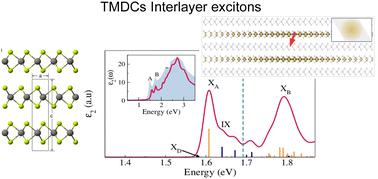当前位置:
X-MOL 学术
›
Phys. Chem. Chem. Phys.
›
论文详情
Our official English website, www.x-mol.net, welcomes your feedback! (Note: you will need to create a separate account there.)
Optical spectra and exciton radiative lifetimes in bulk transition metal dichalcogenides
Physical Chemistry Chemical Physics ( IF 3.3 ) Pub Date : 2024-04-16 , DOI: 10.1039/d3cp05949a Cesar E. P. Villegas 1 , Enesio Marinho 2 , Pedro Venezuela 3 , Alexandre R. Rocha 4
Physical Chemistry Chemical Physics ( IF 3.3 ) Pub Date : 2024-04-16 , DOI: 10.1039/d3cp05949a Cesar E. P. Villegas 1 , Enesio Marinho 2 , Pedro Venezuela 3 , Alexandre R. Rocha 4
Affiliation

|
The optical response of layered transition metal dichalcogenides (TMDCs) exhibits remarkable excitonic properties which are important from both fundamental and device application viewpoints. One of these phenomena is the observation of intralayer/interlayer excitons. While much effort has been done to characterize excitons in monolayer TMDCs and their heterostructures, a quite limited number of works have addressed the exciton spectra of their bulk counterparts. In this work, we employ ab initio many-body perturbation calculations to investigate the exciton dynamics and spectra of bulk 2H-MX2 (M = Mo, W, and X = S, Se). For molybdenum-based systems, we find the presence of interlayer excitons at energies higher than the first bright exciton (XA), with non-negligible strength intensity. Our results also show that interlayer excitons in tungsten-based systems are almost degenerate in energy with XA and possess very small oscillator strengths when compared with molybdenum-based systems. At room temperature, and considering the thermal exciton fine-structure population for the XA-exciton, we estimate effective radiative lifetimes in the range of ∼4–14 ns. For higher energy excitons we predict longer effective lifetimes of tens of nanoseconds.
中文翻译:

块状过渡金属二硫属化物的光谱和激子辐射寿命
层状过渡金属二硫属化物(TMDC)的光学响应表现出显着的激子特性,从基础和器件应用的角度来看,这都很重要。这些现象之一是层内/层间激子的观察。虽然人们在表征单层 TMDC 及其异质结构中的激子方面付出了很多努力,但解决其块体对应物的激子光谱的工作数量相当有限。在这项工作中,我们采用从头开始的多体微扰计算来研究块体 2H-MX 2(M = Mo、W 和 X = S、Se)的激子动力学和光谱。对于钼基系统,我们发现存在能量高于第一亮激子 (X A ) 的层间激子,其强度不可忽略。我们的结果还表明,与钼基系统相比,钨基系统中的层间激子在能量上几乎简并,并且具有非常小的振荡器强度。在室温下,考虑到 X A激子的热激子精细结构布居,我们估计有效辐射寿命在 ∼4–14 ns 范围内。对于更高能量的激子,我们预测其有效寿命更长,可达数十纳秒。
更新日期:2024-04-18
中文翻译:

块状过渡金属二硫属化物的光谱和激子辐射寿命
层状过渡金属二硫属化物(TMDC)的光学响应表现出显着的激子特性,从基础和器件应用的角度来看,这都很重要。这些现象之一是层内/层间激子的观察。虽然人们在表征单层 TMDC 及其异质结构中的激子方面付出了很多努力,但解决其块体对应物的激子光谱的工作数量相当有限。在这项工作中,我们采用从头开始的多体微扰计算来研究块体 2H-MX 2(M = Mo、W 和 X = S、Se)的激子动力学和光谱。对于钼基系统,我们发现存在能量高于第一亮激子 (X A ) 的层间激子,其强度不可忽略。我们的结果还表明,与钼基系统相比,钨基系统中的层间激子在能量上几乎简并,并且具有非常小的振荡器强度。在室温下,考虑到 X A激子的热激子精细结构布居,我们估计有效辐射寿命在 ∼4–14 ns 范围内。对于更高能量的激子,我们预测其有效寿命更长,可达数十纳秒。



























 京公网安备 11010802027423号
京公网安备 11010802027423号